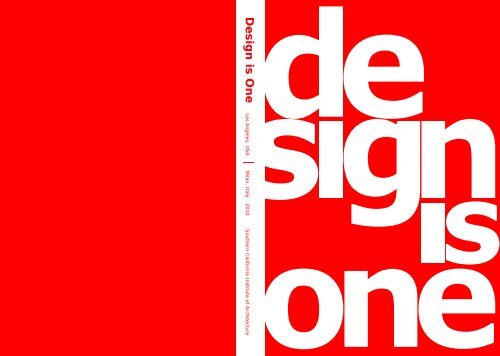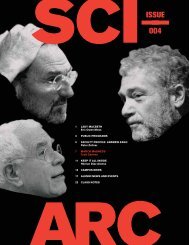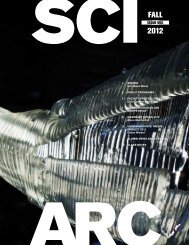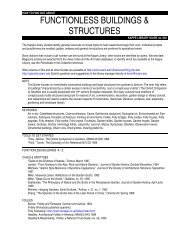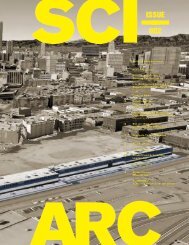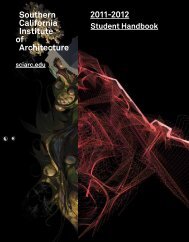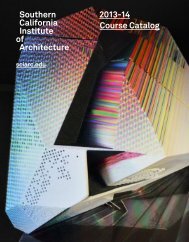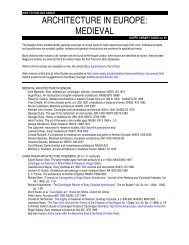Design is One | - Southern California Institute of Architecture
Design is One | - Southern California Institute of Architecture
Design is One | - Southern California Institute of Architecture
Create successful ePaper yourself
Turn your PDF publications into a flip-book with our unique Google optimized e-Paper software.
<strong>Design</strong> <strong>is</strong> <strong>One</strong> Los Angeles, USA | Milan, Italy 2010 <strong>Southern</strong> <strong>California</strong> <strong>Institute</strong> <strong>of</strong> <strong>Architecture</strong>
DESIGN IS ONE 3<br />
LOS ANGELES | MILAN<br />
Part I<br />
Protagon<strong>is</strong>ts
5 Essays<br />
design and modernity<br />
With the predominant use <strong>of</strong> the<br />
same set <strong>of</strong> computer skills in different design<br />
fields, architects are quickly gaining access<br />
to a larger spectrum <strong>of</strong> projects. They<br />
are enabled to design at different scales and<br />
they are <strong>of</strong>ten embracing a multi-d<strong>is</strong>ciplinary<br />
approach in their pr<strong>of</strong>ession. Fabrication has<br />
rapidly become a privileged access to a new<br />
kind <strong>of</strong> craftsmanship that does not depend on<br />
manual skills or local know-how; rather than art<strong>is</strong>ans,<br />
architects now look into robotic capabilities<br />
to transform ideas into reality. And while in<br />
the past 15 years architects have gained new<br />
territories, it <strong>is</strong> clear that contemporary digital<br />
and manufacturing processes have also ra<strong>is</strong>ed<br />
some controversial questions. Is th<strong>is</strong> h<strong>is</strong>torical<br />
moment a rena<strong>is</strong>sance <strong>of</strong> design And if we<br />
believe it <strong>is</strong>, how do we redefine the boundary<br />
<strong>of</strong> our pr<strong>of</strong>ession What are the h<strong>is</strong>torical and<br />
geographical circumstances that previously<br />
caused similar d<strong>is</strong>ciplinary shifts What <strong>is</strong> the<br />
actual relationship between contemporary and<br />
traditional modes <strong>of</strong> production Does all <strong>of</strong><br />
th<strong>is</strong> produce increasing richness or does it flatten<br />
what we do as architects Th<strong>is</strong> book aims<br />
to learn from the recent h<strong>is</strong>tory <strong>of</strong> <strong>Southern</strong><br />
<strong>California</strong> and Northern Italy to answer some<br />
<strong>of</strong> these recurring questions.<br />
The idea that architects would pursue, throughout<br />
their career, a multid<strong>is</strong>ciplinary/multi-scale<br />
production <strong>is</strong> not a new one: they have always<br />
looked beyond the boundaries <strong>of</strong> their d<strong>is</strong>cipline,<br />
appropriating materials, methods and<br />
processes from other industries as needed.<br />
Often in h<strong>is</strong>tory they d<strong>is</strong>gu<strong>is</strong>ed themselves as<br />
art<strong>is</strong>ans, scient<strong>is</strong>ts, art<strong>is</strong>ts and philosophers all<br />
at the same time. In the 1920’s, the Bauhaus<br />
founder Walter Gropius famously declared<br />
that architects should design everything. H<strong>is</strong><br />
school cultivated a totalizing concept in which<br />
architecture was only one aspect <strong>of</strong> design. It<br />
promoted the idea <strong>of</strong> the architect as someone<br />
who could and would design buildings, cities<br />
and objects all with the same involvement. In<br />
Italy the method ‘Dal cucchiaio alla citta’ (“From<br />
the spoon to the city”, Ernesto Rogers, 1952)<br />
was born prec<strong>is</strong>ely from the meeting between<br />
the nascent Prussian industry and the v<strong>is</strong>ionary<br />
educational model developed in Dessau. Th<strong>is</strong><br />
utopian sentence defined an attitude that Italian<br />
designers have developed and sustained since<br />
the 1950’s. Th<strong>is</strong> philosophy found its ground in<br />
the optim<strong>is</strong>tic belief that a newly-born industrial<br />
production once applied to architecture would<br />
be able to produce a better and more affordable<br />
standard <strong>of</strong> living for many people. Th<strong>is</strong><br />
social approach was deeply engaged in the political<br />
dialogue with a growing post-war country<br />
in need <strong>of</strong> progress. A famous example <strong>of</strong><br />
th<strong>is</strong> design philosophy was the light switch that<br />
Castiglioni designed in 1968 for VLM, which he<br />
used to call “h<strong>is</strong> little secret”, because th<strong>is</strong> easily<br />
m<strong>is</strong>sed piece <strong>of</strong> inexpensive hardware was<br />
for him the ultimate anonymous design typology<br />
that improved the quality <strong>of</strong> life in millions<br />
<strong>of</strong> European apartments.<br />
It <strong>is</strong> interesting to notice that 1950’s Italian industrial<br />
technology was primarily applied to object<br />
design and not to architecture, while during<br />
the same period many other states understood<br />
buildings as a symbol for modernity. <strong>One</strong> <strong>of</strong><br />
the main reasons <strong>is</strong> that during the 1920’s and<br />
30’s the fasc<strong>is</strong>t regime chose modern architecture<br />
as a language <strong>of</strong> self-representation, and<br />
after the end <strong>of</strong> the war the newly born Italian<br />
republic went through a cultural reaction to<br />
the idea <strong>of</strong> architectural modernity, which was<br />
still associated with negative political implications.<br />
Throughout the 1950’s and 60’s Italians<br />
chose to express modernity not through their<br />
place <strong>of</strong> living, but through the possession <strong>of</strong><br />
highly crafted and technologically soph<strong>is</strong>ticated<br />
objects, thereby fueling mainly industrial<br />
expansion. After the war several small family
6<br />
businesses grew out <strong>of</strong> their shops and in three<br />
generations they became the famous companies<br />
that still play a leading role in the world<br />
<strong>of</strong> industrial design. These businesses were<br />
<strong>of</strong>ten originated by the v<strong>is</strong>ion <strong>of</strong> a single leader,<br />
who started a small commercial activity revolving<br />
around a specific material craftsmanship or<br />
technical skill. Art<strong>is</strong>ans became mid-size industry<br />
owners, highly specialized not only in terms<br />
<strong>of</strong> creativity in the design process, but also in<br />
production methodologies, earning the trust <strong>of</strong><br />
what “Made in Italy” still means today.<br />
While Italy entered western modernity in the<br />
1950’s, other European countries like Germany,<br />
England, France and United States transitioned<br />
from Arts and Crafts to industrial production<br />
in the mid-19th century. At the end <strong>of</strong><br />
the war, American industrialization was already<br />
establ<strong>is</strong>hed and it did not carry the same political<br />
connotations: <strong>Southern</strong> <strong>California</strong> viewed<br />
technology derived by the military industry as a<br />
symbol <strong>of</strong> modernity and an economic propeller<br />
for the other fields, including architecture.<br />
After WWII John Entenza’s Arts & <strong>Architecture</strong><br />
magazine sponsored the Case Study Houses<br />
program which, from 1945 until 1966, comm<strong>is</strong>sioned<br />
major architects <strong>of</strong> the day (including<br />
Richard Neutra, Charles and Ray Eames,<br />
Pierre Koenig and Eero Saarinen) to design<br />
and build inexpensive and efficient model<br />
homes for the United States residential housing<br />
boom caused by the end <strong>of</strong> war and the<br />
return <strong>of</strong> millions <strong>of</strong> soldiers. The announcement<br />
<strong>of</strong> the program clearly indicated that the<br />
technologies to be used for the design <strong>of</strong> future<br />
dwellings were the ones developed by the military<br />
industry during the war.<br />
“...We <strong>of</strong> course assume that the shape and<br />
form <strong>of</strong> post war living <strong>is</strong> <strong>of</strong> primary importance<br />
to a great many Americans, and that...the<br />
house[s]... will be conceived within the spirit <strong>of</strong><br />
our times, using as far as <strong>is</strong> practicable, many<br />
war-born techniques and materials best suited<br />
to the expression <strong>of</strong> man’s life in the modern<br />
world.”<br />
- Case Study House Program<br />
Arts & <strong>Architecture</strong>, January 1945<br />
It <strong>is</strong> clear that after the end <strong>of</strong> the war <strong>Southern</strong><br />
<strong>California</strong> military industry was forced to<br />
adapt its innovative processes to civil uses and<br />
technology was pragmatically transformed into<br />
a source <strong>of</strong> economical prosperity. Therefore<br />
much <strong>of</strong> the innovation and change in architecture<br />
during that time stemmed from the adoption<br />
<strong>of</strong> production processes based on technology<br />
invented for other industries.<br />
Even the multi-scalar design approach present<br />
in <strong>Southern</strong> <strong>California</strong> was deeply different from<br />
the utopian meaning <strong>of</strong> the phrase “from the<br />
spoon to the city” in Northern Italy. <strong>One</strong> clear<br />
example <strong>of</strong> th<strong>is</strong> dichotomy <strong>is</strong> the nine-minute<br />
film called Powers <strong>of</strong> Ten by Charles and Ray<br />
Eames in 1977. The movie described a design<br />
methodology <strong>of</strong> viewing ideas from an infinitesimal<br />
to a cosmic perspective. Starting with<br />
a sleeping man at a picnic, the film takes the<br />
viewer on a journey out to the edge <strong>of</strong> space<br />
and then back into a carbon atom in the hand<br />
<strong>of</strong> the man at the picnic, all in a single shot.<br />
In th<strong>is</strong> movie sequence, architectural design <strong>is</strong><br />
understood through the eyes <strong>of</strong> a thinker able<br />
to imagine beyond the usual boundaries, more<br />
than a politician in charge <strong>of</strong> the well-being <strong>of</strong><br />
a country. Technology, innovation and experimentation<br />
defined the essential ingredients <strong>of</strong><br />
a pragmatic and optim<strong>is</strong>tic way <strong>of</strong> thinking in a<br />
non-linear fashion. Th<strong>is</strong> blue-sky approach towards<br />
projects <strong>is</strong> typical <strong>of</strong> an American pioneer<br />
culture that relentlessly focuses on Research<br />
and Development <strong>of</strong> new territories rather than<br />
craftsmanship and refinement <strong>of</strong> production.<br />
It <strong>is</strong> not surpr<strong>is</strong>ing that a military invention like<br />
the computer started a revolution in the Silicon<br />
Valley and produced the most relevant number<br />
<strong>of</strong> new typologies in the industrial design field<br />
since Italy in the 1950’s.
7 Essays<br />
It <strong>is</strong> clear that today European architects have<br />
little interest in creating the “total environment”<br />
aspired to by Modern<strong>is</strong>t architects <strong>of</strong> Gropius’<br />
day and that the social agenda promoted by<br />
the utopian phrase “from the spoon to the city”<br />
failed, promoting instead a consumer<strong>is</strong>t approach<br />
to architecture. Lately Italian design<br />
has focused on the refinement and stylization<br />
<strong>of</strong> objects that have been in use for decades,<br />
and the phrase “Made in Italy” <strong>is</strong> now associated<br />
with luxury and perfection rather than innovation.<br />
On the other hand <strong>California</strong> <strong>is</strong> facing<br />
a moment when the moorings <strong>of</strong> global capital<br />
are coming undone and with it the certainties<br />
<strong>of</strong> corporate assumptions, while wars are still<br />
catalyzing the energy <strong>of</strong> the industry and their<br />
innovative capability.<br />
Th<strong>is</strong> multid<strong>is</strong>ciplinary and multi-scale approach<br />
to design that emerged again in architecture<br />
along with the digital revolution needs to be<br />
investigated through a new set <strong>of</strong> ideas. Th<strong>is</strong><br />
book aims to review these dated propositions<br />
and find new ones that reflect the changes that<br />
have taken place in our pr<strong>of</strong>ession.<br />
Elena Manferdini<br />
Los Angeles, June 2010
9<br />
Essays<br />
designing and making:<br />
exploring territoriality “from the spoon to the city”<br />
<strong>Design</strong> <strong>is</strong> <strong>One</strong> investigates the process<br />
<strong>of</strong> making in relationship to its physical<br />
and cultural territories. The development <strong>of</strong> cities<br />
like Milan and Los Angeles benefited from<br />
their adjacency to manufacturing regions which<br />
supported their creative endeavors, allowing<br />
them to develop into urban hubs <strong>of</strong> design innovation.<br />
Th<strong>is</strong> book analyzes, observes and<br />
presents the following propositions within each<br />
city’s h<strong>is</strong>torical and contextual framework:<br />
How does a territory contribute to characterizing<br />
and defining a project and its outcome<br />
How has design helped to shape the cities <strong>of</strong><br />
Milan and Los Angeles How has design been<br />
integrated into economic and cultural forces for<br />
new urban developments<br />
H<strong>is</strong>torically, most <strong>of</strong> the innovation in Los Angeles<br />
has occurred thanks to the film and aerospace<br />
industries. Hollywood flour<strong>is</strong>hed due<br />
to the abundance <strong>of</strong> land and the year round<br />
near-perfect weather conditions. True to the<br />
way movies are made, newer and faster fabrication<br />
technologies such as rapid prototyping,<br />
3D modeling, animation and virtual reality<br />
techniques have emerged within th<strong>is</strong> fertile environment<br />
supported by the availability <strong>of</strong> capital.<br />
The studios’ need for large spaces have<br />
produced a construction <strong>of</strong> the most nondescript<br />
warehouse buildings. Housed within th<strong>is</strong><br />
diffuse banal landscape <strong>of</strong> oversized windowless<br />
boxes, the innovative jewels <strong>of</strong> the movie<br />
industry transform and reconfigure reality into<br />
fiction within their interiors thanks to th<strong>is</strong> building<br />
typology.<br />
The industry also has drawn skillful craftsmen<br />
capable <strong>of</strong> recreating any scenery or building<br />
using the most prosaic materials. The fabrication<br />
techniques applied to economical recreation<br />
<strong>of</strong> ornamentation found on the movie<br />
sets have migrated to the building industry,<br />
garn<strong>is</strong>hing the most flamboyant <strong>of</strong> Beverly Hills<br />
mega-mansions. On a micro scale, movie studios<br />
have influenced the smallest <strong>of</strong> architectural<br />
details on buildings within the city. On a<br />
macro scale the proliferation <strong>of</strong> movie studios<br />
has shaped the development <strong>of</strong> the city, from<br />
Hollywood land, out towards the Valley to the<br />
North and to Culver City in the Southwest.<br />
In the virtual realm <strong>of</strong> influence, the movie industry<br />
has developed soph<strong>is</strong>ticated modeling<br />
and animation techniques to recreate any real<br />
or imaginary world through the use <strong>of</strong> 3D virtual<br />
reality. Contemporary designers have appropriated<br />
these technologies as generative tools,<br />
transforming the process <strong>of</strong> design. With its<br />
skillful craftsmen creating temporary, quick and<br />
inventive architectural solutions, the advanced<br />
s<strong>of</strong>tware <strong>of</strong> th<strong>is</strong> industry continues to inspire<br />
designers, from the Eames on.<br />
At a larger territorial level, <strong>Southern</strong> <strong>California</strong>’s<br />
generously funded military and aerospace industries<br />
have been leaders in engineering<br />
technologies and material science innovation.<br />
The military and aerospace industries and<br />
workforce had to diversify and move into new<br />
industries like sports and construction in the<br />
post-cold war era with the changing demands<br />
and reduced military spending. As a result <strong>of</strong><br />
th<strong>is</strong> change, new materials like composites,<br />
have now become mainstream in transportation<br />
and product design and are slowly being<br />
adopted by the building industry. Currently,<br />
designers experimenting heavily with th<strong>is</strong> new<br />
palette <strong>of</strong> materials, supported by soph<strong>is</strong>ticated<br />
computer modeling s<strong>of</strong>tware to test their proprieties<br />
and robotics to fabricate complex pieces.<br />
Milan owes its prestige and wealth to its excellence<br />
in fashion and design. Milan’s specialty<br />
industries have been some <strong>of</strong> the factors that<br />
contribute to the shaping <strong>of</strong> the ever changing
10<br />
contemporary post-industrial city: showrooms,<br />
fairs, surrounding manufacturing metropolitan<br />
region, the emergence <strong>of</strong> new neighborhoods<br />
and Milan 2015, the Expo, the city’s latest opportunity<br />
for transformation. Neighborhoods<br />
such as Zona Tortona, Bov<strong>is</strong>a, Lambrate, and<br />
Isola, have been transformed by the continued<br />
emergence <strong>of</strong> new activities connected to the<br />
design industry bringing a real change to the<br />
city, beyond its traditional planning and zoning<br />
schemes. The city’s physical renovation happened<br />
over the past fifteen years, via an informal<br />
and un-orchestrated bottom up makeover<br />
where private entrepreneurs appropriated parts<br />
<strong>of</strong> the d<strong>is</strong>mantled industrial city and reoccupied<br />
it with new activities that now open up to the<br />
public at least once a year during the Salone<br />
del Mobile to, like a peacock, show glimpses<br />
<strong>of</strong> the city’s hidden beauty. Together with the<br />
fashion industry, th<strong>is</strong> has provided Milan, over<br />
the past few decades, the real fuel for its physical<br />
and economical transformation.<br />
Milan’s leadership in the design world has been<br />
maintained and renewed every year by the occurrence<br />
<strong>of</strong> the Furniture Fair, the most important<br />
European event which hosts leaders <strong>of</strong><br />
design from around the world for the launch <strong>of</strong><br />
their new products; during the week the city and<br />
its inhabitants live in a 24-hour cycle <strong>of</strong> activities,<br />
rotating around all the showrooms <strong>of</strong> the<br />
Salone and FuoriSalone, d<strong>is</strong>playing to v<strong>is</strong>itors<br />
not only new products but also a slice <strong>of</strong> Italian<br />
cultural and social customs. The event <strong>is</strong> rich<br />
in the so-called “Italian Style” choreographing<br />
the city at different scales with a desire for elegance,<br />
attention to detail, scrutiny <strong>of</strong> materials,<br />
and laborious craftsmanship that <strong>is</strong> nurtured by<br />
a culture aiming for design perfection.<br />
At a larger scale these same economies have<br />
transformed the Northern Italian territory, nurturing<br />
the widespread presence <strong>of</strong> small art<strong>is</strong>an<br />
shops and medium size factories. Today<br />
the Padana plain <strong>is</strong> punctuated by clusters <strong>of</strong><br />
factories, many <strong>of</strong> which, as seen in the case <strong>of</strong><br />
Brianza, a region north <strong>of</strong> Milan, are dedicated<br />
to the production <strong>of</strong> furniture. Here, the family<br />
traditions <strong>of</strong> furniture making, born at the beginning<br />
<strong>of</strong> the nineteen-century, have both conserved<br />
and transformed the manual crafts. Today<br />
we can v<strong>is</strong>it factories, such as Cassina and<br />
Cappellini, which combine high technologies<br />
with ancient know-how. Th<strong>is</strong> century old knowhow,<br />
particularly when using natural materials<br />
such as wood, <strong>is</strong> critical in order to achieve<br />
beautiful, durable pieces. The newest generation<br />
<strong>of</strong> th<strong>is</strong> entrepreneurial population, <strong>of</strong>ten educated<br />
at the Polytechnic in Milan, <strong>is</strong> currently<br />
associating th<strong>is</strong> traditional knowledge with the<br />
most advanced machineries. In the past thirty<br />
years Italian leadership in manufacturing has<br />
expanded to the whole production cycle. Italians<br />
are world leaders in CNC, robotic and machinery<br />
manufacturing technologies, providing<br />
360 degrees <strong>of</strong> innovation in production, from<br />
the 100% hand made to the most complex tooling<br />
technologies. Anything <strong>is</strong> possible in Italy<br />
guided by experienced masters that support<br />
young designers to the process <strong>of</strong> making.<br />
“In Italy the design process <strong>is</strong> not done by designers<br />
only but also by manufacturers. Their<br />
energy and curiosity to say ‘let’s try th<strong>is</strong>’ <strong>is</strong> in<br />
itself an act <strong>of</strong> creativity. “<br />
-Gaetano Pesce<br />
By the middle <strong>of</strong> the twentieth century, the r<strong>is</strong>e<br />
<strong>of</strong> the chemical industry and the d<strong>is</strong>covery <strong>of</strong><br />
the new plastics added a creative alternative<br />
to the furniture design industry already present<br />
in the Brianza region. The Milanese company<br />
Kartell, was the first company to use plastics<br />
in the manufacturing <strong>of</strong> housewares and, later,<br />
furniture. Since the 1950’s Milan has considered<br />
itself as the hub <strong>of</strong> design. Architects<br />
have found themselves involved in designing<br />
at all scales, as Ernesto Rogers, echoing the<br />
Bauhaus total design credo, defined it with the<br />
famous “from the spoon to the city” phrase.<br />
Th<strong>is</strong> phrase, supported critically and conceptually<br />
by academia and design publications, has<br />
been embraced by most <strong>of</strong> the Italian architects<br />
leading to a unique multi-scalar design produc-
11<br />
Essays<br />
tion. However, the real pivotal moment for Italian<br />
international fame in design was defined by<br />
the 1972 MoMA exhibition curated by Emilio<br />
Ambasz, Italy: The New Domestic Landscape.<br />
The exhibition he masterminded left a longlasting<br />
impression within the American design<br />
community, portraying a new and fresh way <strong>of</strong><br />
designing, a way that was not only functional<br />
and rigorous, but allowed a shift from the Bauhaus<br />
lesson to design in the “Italian way”. In<br />
Ambasz’s own words, “V<strong>is</strong>itors were to realize<br />
that design in general, and Italian design<br />
in particular, meant more than simply creating<br />
objects to sat<strong>is</strong>fy functional and emotional<br />
needs: the processes and products <strong>of</strong> design<br />
could themselves be used to <strong>of</strong>fer critical commentary<br />
upon our society.” On another level,<br />
the exhibition sent shock waves through the<br />
community <strong>of</strong> American designers. Here, they<br />
found themselves confronting another breed <strong>of</strong><br />
designers, one unafraid <strong>of</strong> curves and taking<br />
unabashed delight in the sensual attributes <strong>of</strong><br />
the materials and textures he or she used.” The<br />
exhibition’s ripple effects reached well beyond<br />
MoMA’s walls bringing the r<strong>is</strong>e <strong>of</strong> the internationally<br />
recognized “Italian Style”. Since then<br />
the phrase “Made in Italy” has been defined by<br />
the union <strong>of</strong> both design creativity and manufacturing<br />
abilities brimming with social and cultural<br />
implications.<br />
Today Los Angeles and Milan share and face<br />
the same challenges <strong>of</strong> both how to retain their<br />
best creative people, <strong>of</strong>ten attracted by the<br />
eastern emerging dynamic markets, and simultaneously<br />
how to retain their production capacity<br />
locally, not only as a factor <strong>of</strong> providing jobs,<br />
but also, as a means to provide an immense<br />
source <strong>of</strong> inspiration to the many generations<br />
<strong>of</strong> designers to come. The retention <strong>of</strong> such industries<br />
<strong>is</strong> critical to the success <strong>of</strong> these cities.<br />
The twenty-first century brought a set <strong>of</strong> new<br />
challenges related to the rapid decline <strong>of</strong> economic<br />
and environmental resources. How will<br />
design address these changes How will the<br />
new set <strong>of</strong> tools, s<strong>of</strong>tware and hardware available<br />
counterbalance the moving <strong>of</strong> the most<br />
significant productions abroad Is th<strong>is</strong> moment<br />
at once the moment <strong>of</strong> rena<strong>is</strong>sance for mult<strong>is</strong>calar<br />
design, or yet a moment <strong>of</strong> sunset for the<br />
possibility <strong>of</strong> creative and supportive innovation<br />
due to the d<strong>is</strong>appearance <strong>of</strong> production in our<br />
territories How can we learn from our legacies<br />
and be prepared to keep our minds fresh and<br />
in contact with all phases <strong>of</strong> design, from cradle<br />
to cradle<br />
Perhaps little can be done about the current<br />
outsourcing movement, but one can look for<br />
new opportunities. Trends such as the growing<br />
world population benefit us with new immigration<br />
waves. As one <strong>of</strong> the fortunes <strong>of</strong> Los Angeles<br />
<strong>is</strong> its great population diversity, Milan may<br />
find in these new waves <strong>of</strong> multicultural<strong>is</strong>m and<br />
plural<strong>is</strong>m new pools <strong>of</strong> intellectual resources.<br />
Both Milan and Los Angeles share a fragmented<br />
and diverse set <strong>of</strong> specialty clusters that will<br />
allow the cities not only to thrive but to continue<br />
evolving using creativity as their basic fuel for<br />
innovation and transformation. Th<strong>is</strong> will require<br />
the understanding that a territory needs to redefine<br />
its boundaries in order to accommodate<br />
new social changes, be inclusive, and accept<br />
diversity, which in turn will provide the most significant<br />
stimulus for creative thinking. The Expo<br />
2015, “Feeding the Planet, Energy for Life”,<br />
has the rich potential to redefine and expand<br />
the boundaries for Milan. Conceived as an exploration<br />
<strong>of</strong> cultural diversity through food, the<br />
Expo <strong>is</strong> seen as the most prom<strong>is</strong>ing and hol<strong>is</strong>tic<br />
engine for the transformation <strong>of</strong> Milan and to a<br />
lesser extent Northern Italy. As for Los Angeles,<br />
city sprawl and densification <strong>is</strong> the next challenge<br />
to address along with the city’s population<br />
growth. Intervention must be strategic with<br />
funding to create an intense and efficient public<br />
transportation system capable <strong>of</strong> sustaining<br />
large masses using and connecting d<strong>is</strong>parate<br />
neighborhoods.<br />
Another major regional transformation <strong>is</strong> happening<br />
at an infrastructural level. With the<br />
creation <strong>of</strong> a high speed train connecting the
12<br />
major cities, the Padana plain has become one<br />
continuous space, where people and goods<br />
are moved and exchanged in a much more<br />
fluid manner. Similarly, <strong>Southern</strong> and Northern<br />
<strong>California</strong> will also soon be connected by high<br />
speed rail, providing a higher linkage between<br />
the two different economies. These infrastructural<br />
changes together with the continued advancement<br />
<strong>of</strong> high-tech products and services<br />
will allow us to communicate and therefore<br />
evolve in novel ways whereby challenging the<br />
current concept <strong>of</strong> boundaries.<br />
Th<strong>is</strong> book, through the testimony <strong>of</strong> several<br />
contemporary protagon<strong>is</strong>ts <strong>of</strong> both Italian and<br />
American design and manufacturing, answers<br />
these questions with the ultimate proposition<br />
that design evolves within its cultural and social<br />
setting and, consequently, acquires new values<br />
and meaning while maintaining its fundamentals.<br />
<strong>Design</strong> <strong>is</strong> an act <strong>of</strong> creative freedom: in<br />
Los Angeles and Milan we find societies open<br />
to removing physical and social boundaries in<br />
order to create innovative design not only at<br />
the scale <strong>of</strong> products but also at an urban and<br />
cultural level.<br />
Ilaria Mazzoleni<br />
Los Angeles, June 2010
Part I: Protagon<strong>is</strong>ts<br />
Preface<br />
15<br />
Itinerary<br />
17<br />
Maps<br />
20<br />
Don Chadwick<br />
Chadwick Studio<br />
Craig Hodgetts<br />
Hodgetts + Fung<br />
Greg Lynn<br />
Greg Lynn FORM<br />
Gaetano Pesce<br />
Gaetano Pesce the future <strong>is</strong> a very beautiful creature<br />
by Kyd Kitchaiya<br />
77<br />
Alessandro Mendini<br />
Atelier Mendini<br />
design <strong>of</strong> the soul<br />
by Natalie Goldfinger<br />
91<br />
Raffaella Mangiarotti<br />
Deep <strong>Design</strong><br />
beyond styling:<br />
designing from the inside out<br />
by Jordan Su<br />
29<br />
Peter Jon Pearce<br />
Peter Jon Pearce <strong>Design</strong><br />
high performance design<br />
by Heyu Lu<br />
39<br />
play at a human scale<br />
by Elizabeth DeTeresi<br />
51<br />
why be antiquated<br />
by Donovan Ballantyne<br />
65<br />
it’s only natural<br />
by Rina Lim<br />
101
Matteo Ragni<br />
Matteo Ragni Studio intentional design<br />
by Arthur Danielyan<br />
113<br />
Diego Grandi<br />
DGO beneath surfaces<br />
by Joe Carlos<br />
123<br />
Alberto Meda<br />
Alberto Meda<br />
Davide Angeli for<br />
aMDL Michele De Lucchi<br />
design <strong>is</strong> an evolution<br />
by Richard Molina<br />
151<br />
Andreas Kipar<br />
Studio LAND<br />
a simple man<br />
by Matthew Au<br />
137<br />
Diego Terna for<br />
Studio Italo Rota<br />
fashioning architecture<br />
by Genevieve Lum<br />
167<br />
land ho!<br />
by Chiahwa Lu<br />
177<br />
Giovanni La Varra<br />
Studio Barreca & La Varra one city... two city...<br />
old city... new city...<br />
by Matthew Noe<br />
187
15 Preface<br />
The journey started in Los Angeles, where<br />
students met five protagon<strong>is</strong>ts <strong>of</strong> the So-Cal<br />
design scene. The first interview was held at<br />
<strong>Design</strong>work-USA, where the creative director<br />
<strong>of</strong> the product department, Holger Hampf, introduced<br />
the class to a company whose philosthe<br />
protagon<strong>is</strong>ts <strong>of</strong> design<br />
ophy merges the corporate American structure<br />
with a rigorous German approach to design.<br />
Students v<strong>is</strong>ited the <strong>of</strong>fice <strong>of</strong> Greg Lynn, one<br />
<strong>of</strong> the most avant-garde and innovative protagon<strong>is</strong>ts<br />
<strong>of</strong> the design scene in So-Cal, who<br />
embraced the “far west” frontier attitude <strong>of</strong> Los<br />
Angeles adopting new tooling and fabrication<br />
techniques as ways <strong>of</strong> expanding the boundaries<br />
<strong>of</strong> architecture. Don Chadwick and Peter<br />
Jon Pearce shared with the students their personal<br />
and unique perspectives on what really<br />
matters in the design field and helped them to<br />
understand the h<strong>is</strong>torical reasons that made<br />
Los Angeles one <strong>of</strong> the prime centers for design,<br />
while Craig Hodgetts reminded us how<br />
“the new Italian domestic landscape” brought<br />
the Italian design influence to the attention <strong>of</strong><br />
the American public.<br />
While in Milan Alessandro Mendini outlined the<br />
evolution <strong>of</strong> the idea <strong>of</strong> “Industrial <strong>Design</strong>” in<br />
Italy starting after World War II until the past<br />
few decades. Michele De Lucchi <strong>of</strong>fice d<strong>is</strong>cussed<br />
their practice, which literally translates<br />
the concept “from the spoon to the city”<br />
as their <strong>of</strong>fices operate scalarly in th<strong>is</strong> way.<br />
Gaetano Pesce and Italo Rota’s work fluctuates<br />
between art and architecture, where materiality<br />
and craftsmanship are at the center <strong>of</strong><br />
their exploration. Alberto Meda and Raffaella<br />
Mangiarotti embraced the culture <strong>of</strong> industrial<br />
design in the most traditional Milanese sense<br />
with a prolific production that focuses on one<br />
scale but opens their practice to collaborations<br />
with international manufacturing scene. Matteo<br />
Ragni and Diego Grandi, the youngest Italian<br />
voices interviewed, introduced the students to<br />
a d<strong>is</strong>cussion about new materials and languages<br />
<strong>of</strong>ten in dialogue with h<strong>is</strong>tory. Giovanni La<br />
Varra, Andreas Kipar and Luca Molinari helped<br />
us to h<strong>is</strong>torically frame the city <strong>of</strong> Milan, while<br />
providing a v<strong>is</strong>ion for the city that in 2015 will<br />
host the Expo.<br />
d<strong>is</strong>course, together with some specific institutions,<br />
such as La Triennale and the Politecnico<br />
<strong>of</strong> Milan; designers influence culture not only<br />
through their design work, but also through<br />
the animated d<strong>is</strong>cussions which take place in<br />
these venues that are open to a larger public.<br />
The two weeks in Milan ended with a symposium<br />
hosted by NABA, where students had the<br />
opportunity to further d<strong>is</strong>cuss all they had experienced<br />
and observed and to draw parallels<br />
with the pr<strong>of</strong>essional practice as they know it in<br />
the United States. <strong>One</strong> <strong>of</strong> the main questions<br />
that emerged from the symposium was how to<br />
define the new territories (physical and virtual)<br />
the contemporary digital and manufacturing<br />
processes have opened up to our field.<br />
The different approaches to the definition <strong>of</strong><br />
architectural education and its h<strong>is</strong>torical tendency<br />
to cross fields with other d<strong>is</strong>ciplines constitutes<br />
the core for th<strong>is</strong> book, the aim <strong>of</strong> which<br />
<strong>is</strong> to re-contextualize these <strong>is</strong>sues and to find<br />
a h<strong>is</strong>torical perspective bridging the Italian tradition<br />
<strong>of</strong> design <strong>is</strong> one with the contemporary<br />
American design macro-trends.<br />
Elena Manferdini & Ilaria Mazzoleni<br />
Los Angeles, July 2010<br />
During the trip students v<strong>is</strong>ited the headquarters<br />
<strong>of</strong> magazines like Domus and Abitare,<br />
that h<strong>is</strong>torically played a key role in the design
65<br />
Greg Lynn<br />
1817 Lincoln Boulevard,<br />
Venice, CA 90291<br />
GREG LYNN FORM
Images <strong>of</strong> Greg Lynn’s Venice<br />
studio<br />
66
67<br />
Biography<br />
why be antiquated<br />
Avant-garde represents a violent<br />
fight against the things that pollute our cities,<br />
our culture, and our lives; against everything<br />
that <strong>is</strong> static and unchanging, the norm and<br />
the status quo. Interestingly enough, avantgarde<br />
was originally a French term used<br />
to describe the foremost part <strong>of</strong> an army<br />
advancing into battle, the “advance guard.”<br />
In the fight for <strong>Architecture</strong> there <strong>is</strong> no<br />
one more significant for inducing avantgarde<br />
change in the pr<strong>of</strong>ession than Greg<br />
Lynn. Lynn was born in Ohio in 1964. He<br />
attended Miami University <strong>of</strong> Ohio where<br />
he graduated cum laude with two degrees<br />
in 1986, one in environmental design and<br />
the other in philosophy. In the traditional<br />
architecture sense, these two phenomena<br />
coincide quite regularly, but Lynn applies h<strong>is</strong><br />
learnt knowledge in a very non-traditional<br />
way. After h<strong>is</strong> success at Miami University <strong>of</strong><br />
Ohio, Lynn was accepted into the Masters<br />
<strong>of</strong> <strong>Architecture</strong> program at the prestigious<br />
Princeton University where he studied under<br />
Michael Graves, among other influential<br />
architects and designers. Lynn graduated in<br />
1988 before he went on to work for Peter<br />
E<strong>is</strong>enman.<br />
<strong>of</strong> architectural ontologies. Ontologies in<br />
which he believes and argues to be calculus<br />
based.<br />
While Greg’s <strong>of</strong>fice <strong>is</strong> relatively small, it <strong>is</strong><br />
impossible to not be amazed by all <strong>of</strong> the<br />
interesting models and installation pieces<br />
that completely fill the space. During our<br />
v<strong>is</strong>it, Greg gave us a tour around h<strong>is</strong> <strong>of</strong>fice,<br />
which <strong>is</strong> compr<strong>is</strong>ed <strong>of</strong> a small meeting<br />
space, work stations, and model shop<br />
where he uses h<strong>is</strong> CNC milling machine for<br />
prototyping and laser cutters, as well as 3D<br />
printers for study and final models. While<br />
Greg <strong>is</strong> an architect, he <strong>is</strong> also a designer<br />
that takes on projects ranging in scale<br />
from silverware to boats to buildings. As an<br />
architect, a teacher, and a writer, he has had<br />
an extremely strong impact on the current<br />
trends in architecture. Greg began to crosspollinate<br />
some <strong>of</strong> the design techniques used<br />
by the automotive and animation industries<br />
in the nineties to influence the integration<br />
<strong>of</strong> digital technologies and manufacturing<br />
used by these industries within the practice<br />
<strong>of</strong> architecture, which currently uses these<br />
same tools.<br />
It was in 1992 that Lynn establ<strong>is</strong>hed h<strong>is</strong> own<br />
firm, FORM, and moved h<strong>is</strong> headquarters<br />
to Venice, <strong>California</strong> in order to be near<br />
Hollywood and the new animation s<strong>of</strong>tware<br />
programs used by film animators. H<strong>is</strong> firm<br />
works on everything from architecture and<br />
urban design, exhibit design and curation,<br />
and branding and advancing digital design<br />
tools. Time Magazine recently named Greg<br />
Lynn one <strong>of</strong> the 100 innovators <strong>of</strong> the next<br />
century. Greg <strong>is</strong> fascinated by mathematics,<br />
order, and form. He believes architecture<br />
<strong>is</strong> not a practice, but a d<strong>is</strong>cipline through<br />
which the development and process are an<br />
integral force in the continuous evolution
68<br />
TOP<br />
Alessi Flatware<br />
Middle Top<br />
Catamaran <strong>Design</strong><br />
for client in Abu Dhabi<br />
Middle Bottom<br />
Wilshire Pavillion Los Angeles<br />
Bottom<br />
Blob Wall
69<br />
Interview<br />
Th<strong>is</strong> interview took place at Greg Lynn’s <strong>of</strong>fice<br />
in Venice, <strong>California</strong>. H<strong>is</strong> <strong>of</strong>fice <strong>is</strong> located where<br />
most <strong>Southern</strong> <strong>California</strong> architects would like<br />
to work; next to the beach. It <strong>is</strong> in a small<br />
building camouflaged along the Los Angeles<br />
urban streetscape. The only element that<br />
suggests that th<strong>is</strong> <strong>is</strong> an architectural <strong>of</strong>fice <strong>is</strong> a<br />
very small sign that states, “Greg Lynn FORM”<br />
on the top right location on the front door. Th<strong>is</strong><br />
was very interesting, because through th<strong>is</strong> door<br />
our class entered another world that was filled<br />
with exciting avant-garde design that was the<br />
complete opposite experience from the banal<br />
streetscape that ex<strong>is</strong>ted outside.<br />
Donovan Ballantyne : Having worked on<br />
multi-d<strong>is</strong>ciplinary projects differing in scale<br />
from silverware to boats, to architecture,<br />
how does the design process change for<br />
you when approaching the different design<br />
problems associated with these different<br />
project types<br />
Greg Lynn: By starting with the typology, with<br />
some kind <strong>of</strong> precedent or problem that could<br />
be clearly stated. I usually look to h<strong>is</strong>toric<br />
examples and try to see what problems were<br />
trying to be solved, and then try to re-define<br />
what the problem would be or re-think what<br />
happens. I am not a person that likes to refine<br />
things on a project. For me it <strong>is</strong> more interesting<br />
re-defining the problem for every new project,<br />
but to do that I have to look h<strong>is</strong>torically and see<br />
what it once was. The way naval architects<br />
think about the design from the deck down in<br />
terms <strong>of</strong> how things move through the water<br />
and how much volume there <strong>is</strong> for function.<br />
Then everything above the deck <strong>is</strong> like a little<br />
house, which <strong>is</strong> why they call it the cabin. It <strong>is</strong><br />
literally like a little hut that they put on top <strong>of</strong><br />
it. Th<strong>is</strong> <strong>is</strong> how it has always been thought <strong>of</strong>:<br />
the deck <strong>is</strong> the ground, and the hut <strong>is</strong> the cabin<br />
top. For all <strong>of</strong> these boat projects, I have been<br />
trying to find a way to treat the cabin not as a<br />
little house, but as a part <strong>of</strong> the surfacing <strong>of</strong> the<br />
hulls and the deck. It <strong>is</strong> actually the same thing<br />
Philippe Starck did when he designed boats for<br />
Beneteau. It <strong>is</strong> the same approach to design<br />
for the flatware or even the restaurant pavilion;<br />
it’s about how to make a trell<strong>is</strong> and how to turn<br />
the building into the columns that support the<br />
trell<strong>is</strong>.<br />
DB : Can you d<strong>is</strong>cuss the benefits you<br />
have found within your practice having<br />
approached architecture from multiple<br />
directions from writing, building, and<br />
teaching Do you feel that th<strong>is</strong> <strong>is</strong> the best<br />
path for the next generation <strong>of</strong> architects as<br />
well<br />
GL: It <strong>is</strong> hard to find a time when architects were<br />
not writing; making manifestoes, relationships<br />
to h<strong>is</strong>tory or even explanations based on<br />
engineering. What you always find <strong>is</strong> that not<br />
all, but most architects write. Also, most are<br />
involved in some form <strong>of</strong> industrial design. The<br />
architects that I was taught by as well as my<br />
mentors did it all in parallel. Especially when<br />
I went to school in the 80s, that was when<br />
Swid-Powell, Alessi, Knoll and Vitra were all<br />
using architects to redefine their industrial<br />
design language, and likew<strong>is</strong>e, people like<br />
that also helped architects re-think their design<br />
language and how the communicated with the<br />
design public. In the 80s with post-modern<strong>is</strong>m,<br />
there were connections between industrial<br />
design and architecture and all kinds <strong>of</strong> forms<br />
<strong>of</strong> design. That was the norm, more the rule<br />
than the exception. However, It was a little bit<br />
different in the 90s. <strong>Architecture</strong> was looking<br />
more at design rather than design looking at<br />
architecture.<br />
DB: Having been influenced by a variety<br />
<strong>of</strong> d<strong>is</strong>ciplines from animation to the<br />
automotive industry, can you d<strong>is</strong>cuss<br />
your views on why collaboration between<br />
d<strong>is</strong>ciplines <strong>is</strong> so important to architecture<br />
GL: Looking to the entertainment industry<br />
was a way to get tools that would be useful for<br />
design. But what happened while I was doing<br />
that <strong>is</strong> I found out that the entertainment industry
70<br />
thinks about the audience, or thinks about how<br />
somebody <strong>is</strong> going to be experiencing their<br />
design before they even start designing. With<br />
the Korean church we had an idea about how it<br />
would be like a church, but we did not have an<br />
idea about how it would relate to the Korean-<br />
American population at that point in time, and<br />
how they would interpret the architecture.<br />
We were really just thinking in the kind <strong>of</strong> big<br />
h<strong>is</strong>tory, we weren’t thinking <strong>of</strong> our audience<br />
at the contemporary moment, whereas film<br />
and telev<strong>is</strong>ion were thinking about the h<strong>is</strong>tory<br />
<strong>of</strong> their field, they mostly thought about how<br />
it was going to be received and experienced.<br />
It has really changed the way I have thought<br />
about design, because that kind <strong>of</strong> impact on<br />
somebody <strong>is</strong> more interesting than the whole<br />
h<strong>is</strong>torical d<strong>is</strong>cussion. That <strong>is</strong> why the work I am<br />
doing at UCLA with D<strong>is</strong>ney right now <strong>is</strong> really<br />
fun, because D<strong>is</strong>ney thinks <strong>of</strong> their parks and<br />
resorts and cru<strong>is</strong>e ships, etc. really in terms <strong>of</strong><br />
guests and audience.<br />
The part <strong>of</strong> your question pertaining to<br />
collaboration <strong>is</strong> really important. Everybody <strong>is</strong><br />
using the exact same s<strong>of</strong>tware now. Ten years<br />
ago, everybody had their own boutique jewels,<br />
now there are really only three major platforms,<br />
if that. Most people use the Autodesk toolset.<br />
In the movie Avatar they tried using Revit for<br />
managing some <strong>of</strong> those scenes, so they were<br />
really deep into the same toolset that architects<br />
are using. So, you could have a d<strong>is</strong>cussion<br />
with them. Everybody <strong>is</strong> producing different<br />
things, but they are all using the same media<br />
to a certain extent. By collaborating you learn<br />
about the media differently by working with<br />
other d<strong>is</strong>ciplines.<br />
DB: Do you believe your career would have<br />
been as successful if you did not make the<br />
dec<strong>is</strong>ion to move Greg Lynn FORM from<br />
New Jersey to Los Angeles and why<br />
GL: It <strong>is</strong> all hypothetical. The culture <strong>of</strong> making<br />
stuff out <strong>of</strong> aerospace grade to d<strong>is</strong>posable<br />
Hollywood set grade <strong>is</strong> really interesting here.<br />
There’s a much more precious attitude towards<br />
construction in most places around the world.<br />
Here materials and construction methods are<br />
less precious. I do not think I would be using<br />
materials like the Swarovski Crystal sails, but<br />
all that stuff <strong>is</strong> really more West Coast based<br />
from the aerospace industry, and a little bit from<br />
the car industry. So that <strong>is</strong> different, I would<br />
have less focus on materials and method <strong>of</strong><br />
construction if I were someplace else. The<br />
whole entertainment culture here <strong>is</strong> totally<br />
unique. I would not have got involved with<br />
projects like the New City and Divide projects<br />
if I was not out here. For quite awhile LA has<br />
been the epicenter for American architecture.<br />
From Frank Gehry to Thom Mayne, there<br />
are a number <strong>of</strong> people here practicing at<br />
an international level that you do not find<br />
anywhere else in the states. In New York, I<br />
felt that the key figures were Steve Holl and a<br />
few others who were much more idiosyncratic<br />
in their approach. New York and New Jersey -<br />
that whole area – such as Princeton, Yale, have<br />
a deep connection to international architecture<br />
culture that does not ex<strong>is</strong>t in LA. Also, there are<br />
great institutions there but the architects are<br />
probably much stronger here than other places.<br />
DB: Having paved the way for the pr<strong>of</strong>ession<br />
<strong>of</strong> architecture for almost 20 years, if you<br />
were to look back at a younger Greg Lynn,<br />
<strong>is</strong> the current state <strong>of</strong> architecture what you<br />
would have env<strong>is</strong>ioned And if not, what<br />
would you have changed<br />
GL: 20 years ago, a lot <strong>of</strong> things that are now<br />
standard, I would never have thought would<br />
be standard. 20 years ago I was drafting with<br />
ink on mylar and cutting models by hand. You<br />
would do a set <strong>of</strong> drawings and it was 25% as<br />
many as you would do now, and you would<br />
completely rely on somebody else to build stuff.<br />
20 years ago the engineering firms were very<br />
small like architecture firms, usually around<br />
10 person firms. ARUP, Thorton Tomasetti<br />
and Happold were big international firms, but<br />
they didn’t have as much control. It’s funny
71<br />
that things have really changed a lot; very<br />
few people are trying to take control <strong>of</strong> how<br />
to build things and how to talk through the<br />
engineers and through the builders, but now<br />
the architects are much weaker in terms <strong>of</strong> their<br />
control and influence than they were 20 years<br />
ago. If you want to do something, you have to<br />
take more r<strong>is</strong>ks and do more work. I would not<br />
have foreseen the whole field dimin<strong>is</strong>hing the<br />
way it has in 20 years, in very general terms.<br />
I also would have seen a lot <strong>of</strong> the things that<br />
I am interested in become so normal for so<br />
few people. I wouldn’t have imagined 20 years<br />
ago that Frank Gehry would have a s<strong>of</strong>tware<br />
company. But he takes a lot <strong>of</strong> r<strong>is</strong>ks and <strong>is</strong><br />
very entrepreneurial that way. I think in general<br />
the normal architect has much less control on<br />
a building site, less reach into design culture<br />
outside <strong>of</strong> the building industry and therefore<br />
<strong>is</strong> less <strong>of</strong> a cultural figure. Of course there are<br />
important exceptions but the field <strong>is</strong> smaller<br />
and less ambitious and entrepreneurial.<br />
DB: Where do you see architecture going<br />
within the next twenty years, and how are<br />
your latest projects, like your New City<br />
project, a part <strong>of</strong> that<br />
GL: In terms <strong>of</strong> the long-term, things are going<br />
back more to the way they once were. The<br />
giant service firms have been hit worse than<br />
anybody right now, which <strong>is</strong> good. The kind<br />
<strong>of</strong> instant city phenomenon has really cooled<br />
<strong>of</strong>f. So instead <strong>of</strong> needing to provide a really<br />
economical service so you can build a series <strong>of</strong><br />
towers really fast in a place with low skill level,<br />
now we are seeing a return to high quality,<br />
thoughtful design, and good quality products;<br />
things that both last literally and culturally.<br />
There <strong>is</strong> not a lot that has been done in the<br />
last ten years that you would call landmark.<br />
Architects will go back to thinking about those<br />
kinds <strong>of</strong> <strong>is</strong>sues, which I think, in general, they<br />
have not thought about so much. Universities<br />
and publications, etc. are becoming more<br />
important again. However, I don’t think there<br />
are any really good publications out there right<br />
now, and I do not think there are any really great<br />
conferences out there anymore. 20 years ago,<br />
that stuff was really driving the field, but right<br />
now it <strong>is</strong> just more a way for people to publicize<br />
their work. So hopefully 20 years from now you<br />
will see more international conferences, strong<br />
schools, and a better quality <strong>of</strong> design within<br />
the field. Probably less quantity though.<br />
DB: Maybe it’s more like your w<strong>is</strong>hes in 20<br />
years , maybe th<strong>is</strong> question <strong>is</strong> more about<br />
what you would see…<br />
GL: For the field, what I really m<strong>is</strong>s are<br />
conferences; I m<strong>is</strong>s the AA as a real kind <strong>of</strong><br />
public, cultural place in Europe. There are<br />
all kinds <strong>of</strong> things I really m<strong>is</strong>s in terms <strong>of</strong><br />
architecture as a cultural practice, like the<br />
connections to the art and design world; I really<br />
m<strong>is</strong>s that stuff a lot and hope that it comes<br />
back, but right now I do not know where it<br />
went. I guess there <strong>is</strong> not money for that stuff.<br />
Also the whole publ<strong>is</strong>hing industry <strong>is</strong> trying to<br />
figure out the Internet. I know you guys are<br />
all students and maybe you are different, but<br />
I know my students at Yale and UCLA, they<br />
really do not know stuff they should know just<br />
because it does not ex<strong>is</strong>t on the Internet. They<br />
do not see Bramante, Bernini or Palladio, there<br />
are all sorts <strong>of</strong> architects and building that have<br />
come up that I have asked my students about,<br />
and they are not aware <strong>of</strong> them because if you<br />
want to go find the Heidi Weber Pavilion online,<br />
there are just not that many drawings <strong>of</strong> it, or<br />
not that many photographs <strong>of</strong> it, whereas, for<br />
me, I had Corbusier’s Ouvre Complete, like 12<br />
volumes in my library that I could always go to.<br />
I did not know it all, but if I wanted to find it, I<br />
could go find the sketch for it. If you wanted<br />
to find a sketch for the Heidi Weber Pavilion<br />
online, I am guessing you would have a hard<br />
time finding it. The accrediting team just came<br />
to UCLA and talked about how great the library<br />
was, and I asked my students if they had ever<br />
been to the library and literally none <strong>of</strong> them<br />
had ever set foot in the architecture library.
72<br />
Top<br />
Greg Lynn<br />
Middle<br />
Ravioli Chairs for Vitra<br />
Bottom<br />
UCLA’s Hammer Museum Fountain
73<br />
DB: So do you feel like the internet <strong>is</strong><br />
strengthening or weakening the field <strong>of</strong><br />
architecture<br />
GL: <strong>One</strong> thing that <strong>is</strong> good, <strong>is</strong> that over the last<br />
5 or 10 years more architects’ websites are<br />
available online. But nobody has digitized the<br />
collection you see in the library. All the drawings<br />
and photographs <strong>of</strong> models that you get out<br />
<strong>of</strong> the monograph just do not ex<strong>is</strong>t online. My<br />
students at UCLA are studying Ledoux right<br />
now, and some <strong>of</strong> them did not really even<br />
know who Ledoux was because you can’t find<br />
h<strong>is</strong> drawings online. Your generation will have<br />
to figure out within the internet how to re-learn<br />
that stuff.<br />
DB: Th<strong>is</strong> class <strong>is</strong> about Milan, <strong>Southern</strong><br />
<strong>California</strong> and Italy’s design culture. Is<br />
there any influence or any relevance in your<br />
work that comes from Italy<br />
GL: Italy <strong>is</strong> definitely a design hub, It <strong>is</strong> still<br />
hosting design in a way that other places are<br />
not. Both publ<strong>is</strong>hing and design fairs are still<br />
very important in Italy. People like, Patrizia<br />
Moroso are finding out where the design talent<br />
<strong>is</strong> and experimenting with where it <strong>is</strong> going. In<br />
addition, Italy <strong>is</strong> still hosting design in a way<br />
that other places are not, Italian design fairs<br />
manage to strike a good balance between<br />
a commercial fair, being provocative, and<br />
connecting with the art community.<br />
Interview by Donovan Ballantyne<br />
April 27, 2009
74<br />
Interview by Lorka Birn<br />
May 14, 2009<br />
Top<br />
ICA Numinous Lights<br />
Middle<br />
World Trade Center<br />
<strong>Design</strong> Competition New York<br />
Bottom<br />
Toy Robot installtion for Vitra
75 Conclusion<br />
Greg Lynn <strong>is</strong> a fascinating<br />
character that <strong>is</strong> quite particular from the<br />
rest <strong>of</strong> the designers we interviewed within<br />
th<strong>is</strong> publication. A major difference <strong>is</strong> Lynn’s<br />
Los Angeles location, where the automotive,<br />
animation, and aerospace industries have<br />
had a strong impact on h<strong>is</strong> work. The digital<br />
fabrication methods deployed in Los Angeles<br />
are a lot more advanced than those in Milan,<br />
which <strong>is</strong> evident in Lynn’s work.<br />
Lynn uses digital fabrication methods as a<br />
means <strong>of</strong> justifying craftsmanship within h<strong>is</strong><br />
work. Craftsmanship <strong>is</strong> traditionally defined<br />
as pertaining to things that are handmade;<br />
however th<strong>is</strong> definition does not suffice for<br />
the new era <strong>of</strong> design. The new definition <strong>of</strong><br />
craftsmanship pertains to the art <strong>of</strong> making,<br />
and whether that process <strong>is</strong> handmade or<br />
through digital fabrication tools <strong>is</strong> irrelevant.<br />
Italy <strong>is</strong> a country known for its handcraft, as<br />
illustrated for our class when we v<strong>is</strong>ited a<br />
master handcrafter who worked for the furniture<br />
company Cappellini. During our v<strong>is</strong>it, we<br />
witnessed an old man weave yarn through the<br />
structure <strong>of</strong> one <strong>of</strong> the company’s chairs. It was<br />
both beautiful and inspirational knowing that he<br />
has been doing th<strong>is</strong> since he was twelve years<br />
old, and that there <strong>is</strong> nothing he loves more<br />
than spending h<strong>is</strong> time doing what he does.<br />
However, it <strong>is</strong> becoming increasingly difficult to<br />
find people with h<strong>is</strong> level <strong>of</strong> hand craftsmanship<br />
within the industry, and in the next twenty years<br />
there will not be anyone left that can perform at<br />
h<strong>is</strong> handcraft skill level. The use <strong>of</strong> technology<br />
as a means <strong>of</strong> craftsmanship grants designers<br />
an endless palate <strong>of</strong> design techniques that<br />
handcraft techniques just cannot compete<br />
with. Lynn takes advantage <strong>of</strong> CNC milling<br />
and 3D printing to create complex prototypes<br />
to develop differentiation and transformations<br />
within h<strong>is</strong> work.<br />
to as a “plane <strong>of</strong> cons<strong>is</strong>tency” upon which<br />
differential transformations occur.” (Folds,<br />
Bodies, & Blobs, p.38) For Lynn, geometry <strong>is</strong><br />
about force, motion and flow; motion becomes<br />
the primary mode <strong>of</strong> organization, construction,<br />
composition, and stability. In the case <strong>of</strong> h<strong>is</strong><br />
Korean Presbyterian Church in New York,<br />
Greg composes th<strong>is</strong> project with a series <strong>of</strong><br />
folded and shredded surface strips that run<br />
though both the exterior and the interior, and<br />
<strong>of</strong>fer a sense <strong>of</strong> movement through differential<br />
transformations. Each element in the structure<br />
has a unique scalar d<strong>is</strong>tance, as well as a unique<br />
angle. Th<strong>is</strong> creates a v<strong>is</strong>ual differentiation<br />
while also demonstrating repetition.<br />
<strong>One</strong> <strong>of</strong> Lynn’s significant traits <strong>is</strong> that he<br />
approaches design by starting with the typology,<br />
with some kind <strong>of</strong> precedent or problem for<br />
every design regardless <strong>of</strong> scale. It <strong>is</strong> Lynn’s<br />
ability to shift within a range <strong>of</strong> multid<strong>is</strong>ciplinary<br />
projects from h<strong>is</strong> Korean Presbyterian Church,<br />
and then design silverware for Alessi, and<br />
boats for Abu Dhabi as well as h<strong>is</strong> avant-garde<br />
craftsmanship that makes him a reputable<br />
“<strong>Design</strong> <strong>is</strong> <strong>One</strong>” architect.<br />
“Geometry <strong>is</strong> no longer a static measure <strong>of</strong><br />
invariant and unitary character<strong>is</strong>tics, but what<br />
Gillies Deleuze and Felix Guattari have referred
Via Sannio, 24<br />
20135 Milano
TOP<br />
A sample <strong>of</strong> material to be used<br />
<br />
cabinets<br />
MIDDLE TOP<br />
<strong>Design</strong> tools and materials<br />
MIDDLE BOTTOM<br />
Francesco in the studio<br />
BOTTOM<br />
The entrance to the studio, a<br />
latent indication <strong>of</strong> the work<br />
inside<br />
86
from the infinitesimal to<br />
the infinite<br />
Alessandro Mendini, born in Milan<br />
in 1931, has been the chief editor <strong>of</strong> the<br />
magazines Casabella, Modo and Domus.<br />
He designs objects, furniture, environments,<br />
paintings, installations and architecture. He<br />
works with international companies like Alessi,<br />
Philips, Cartier, B<strong>is</strong>azza, Swatch, Hermes and<br />
Venini and also acts as a consultant curator<br />
for various industries helping them to solve<br />
problems related to image and design.<br />
H<strong>is</strong> work can be found in various museums and<br />
private collections as well as on the wr<strong>is</strong>ts and<br />
in the homes <strong>of</strong> the tens <strong>of</strong> thousands <strong>of</strong> people<br />
who have purchased products from Swatch or<br />
Alessi over the past decades. H<strong>is</strong> work as<br />
a theoretician, critic and designer <strong>is</strong> always<br />
developed at the crossroads between art,<br />
design and architecture. Put best by Beatrice<br />
<br />
body <strong>of</strong> work, “If the slogan <strong>of</strong> modern design<br />
was ‘from the spoon to the city,’ with Mendini it<br />
1 .<br />
Armed with h<strong>is</strong> Stileme, a body <strong>of</strong> symbols that<br />
have come to be the v<strong>is</strong>ual alphabet through<br />
which Mendini has spoken for decades, he<br />
shifts through many different worlds while<br />
<br />
him to communicate across many mediums.<br />
It <strong>is</strong> a v<strong>is</strong>ual language dynamic enough to apply<br />
to multiple dimensions and scales yet simple<br />
enough to ex<strong>is</strong>t wholly in a singular template,<br />
seen in h<strong>is</strong> Mendini-graph, a multidimensional<br />
mult<strong>is</strong>calar tool. H<strong>is</strong> ability to shift h<strong>is</strong> eye<br />
from the design <strong>of</strong> a factory to the design <strong>of</strong> a<br />
watch to the curation <strong>of</strong> an entire transportation<br />
system to a one-<strong>of</strong>-a-kind sculpture <strong>is</strong> certainly<br />
the envy <strong>of</strong> most designers.<br />
In the 1970s, Alessandro was a main<br />
personality for the radical design movement in<br />
Italy. In a time when very little was being built or<br />
produced in h<strong>is</strong> part <strong>of</strong> the world, Mendini took<br />
to designing a way <strong>of</strong> thinking which would lay<br />
the ground for all <strong>of</strong> h<strong>is</strong> work to come. During<br />
th<strong>is</strong> time Alessandro joined Studio Alchimia<br />
<br />
avant- garde including Ettore Sottsass, Andrea<br />
Branzi and Michele DeLucchi. The group’s<br />
exhibitions payed special attention to everyday<br />
objects and products whose inherent banality<br />
was accentuated by the addition <strong>of</strong> dramatic<br />
decorative features. It <strong>is</strong> with th<strong>is</strong> group that<br />
Alessandro was free to operate outside the<br />
constraints <strong>of</strong> mass production and to develop<br />
h<strong>is</strong> approach as a critic and editor. It was with<br />
Studio Alchimia where he initially began to<br />
balance th<strong>is</strong> multiplicity as both architect and<br />
critic, editor and curator, which would come to<br />
<br />
From there he was able to further develop<br />
h<strong>is</strong> ways <strong>of</strong> thinking with the Memph<strong>is</strong> Group,<br />
founded by fellow member <strong>of</strong> Studio Alchimia<br />
E. Sottsass. The group’s work debuted at the<br />
1981 Milan Salone del Mobile. Deriving its<br />
name from the Bob Dylan song Stuck Inside<br />
<strong>of</strong> Mobile With the Memph<strong>is</strong> Blues Again, the<br />
<br />
1980s and found assurance in considering itself<br />
a fashion rather than academic movement.<br />
<br />
balance between opposing elements.<br />
Th<strong>is</strong> balance can clearly be seen in the work<br />
that the studio has produced since 1989 when<br />
Alessandro began Atelier Mendini with h<strong>is</strong><br />
brother Francesco. The studio <strong>is</strong> currently<br />
working on a number <strong>of</strong> products for Alessi,<br />
developing curatorial and design work for the<br />
Naples subway system, creating art pieces<br />
for Cartier in addition to other projects and<br />
Alessandro’s work as a writer and a critic. H<strong>is</strong><br />
objects, h<strong>is</strong> environments and h<strong>is</strong> ideas seem<br />
to have permeated the entire world <strong>of</strong> design<br />
from design for mass production to design as a<br />
singular art form.<br />
87
TOP<br />
Alessi factory with color<br />
schemes and interiors by Atelier<br />
Mendini<br />
MIDDLE TOP<br />
The Proust Chair in production<br />
at the Cassina factory<br />
MIDDLE BOTTOM<br />
An application <strong>of</strong> 2D shapes in<br />
3D form<br />
BOTTOM<br />
A reinvention <strong>of</strong> the Proust Chair<br />
as seen in the most recent Fiore<br />
Salone<br />
88
Located in an unassuming neighborhood on<br />
the perimeter <strong>of</strong> a city that he has called home<br />
for many dini<br />
seems small in compar<strong>is</strong>on to the massive<br />
body <strong>of</strong> work he has produced over the past<br />
decades. At Atelier Mendini we were fortunate<br />
enough to speak with both Alessandro and<br />
Francesco, as well as essential members <strong>of</strong><br />
their design team, about their design philoso-<br />
<br />
<strong>of</strong> which proved to be the group <strong>of</strong> signs and<br />
symbols they have developed as a v<strong>is</strong>ual language.<br />
<br />
<br />
stileme<br />
<br />
Alessandro Mendini: In the beginning I started<br />
studying cub<strong>is</strong>m and futur<strong>is</strong>m. My studies are<br />
very strongly connected to futur<strong>is</strong>m. Not only<br />
with the signs but with the colors as well. The<br />
signs are very emotional and strong. It’s a<br />
kind <strong>of</strong> novel on the objects. It <strong>is</strong> an emotional<br />
communication, a poetry. For me, my work<br />
<strong>is</strong> based on those alphabets so I use the<br />
alphabets for all <strong>of</strong> my work.<br />
Francesco Mendini: The signs are a continuous<br />
play <strong>of</strong> changing scale and decoration. They<br />
can move between 2D and 3D, from the small<br />
scale to the large scale. Sometimes the objects<br />
are the signs and sometimes the signs are on<br />
the objects. They are applicable to multiple<br />
levels <strong>of</strong> project.<br />
<br />
<br />
<br />
<br />
<br />
<br />
<br />
AM: Of course, there are many ways to understand<br />
an object or a space. There are different<br />
possibilities <strong>of</strong> interpretation. The alphabets<br />
change a lot over time as well as the colors, so<br />
everything changes. For example, designing<br />
a watch with all <strong>of</strong> its particular mechanics and<br />
designing an art object without prec<strong>is</strong>e function<br />
provide two very different situations in which to<br />
utilize the stileme.<br />
FM: The choice <strong>of</strong> symbols depends on many<br />
things although they are rarely tied to the<br />
location <strong>of</strong> a work. But scale, for example,<br />
gives you multiple ways to understand an<br />
object and <strong>of</strong>fers a means <strong>of</strong> shifting the use <strong>of</strong><br />
the stileme. A change in scale can change the<br />
reading <strong>of</strong> an object completely. It’s a question<br />
<strong>of</strong> the relationship between you and the object.<br />
<br />
<br />
<br />
AM: As an example, a piece <strong>of</strong> jewelry might<br />
have the same shape as a tower. But here our<br />
methods can adjust through materiality. So a<br />
ring can be like a tower in gold or it can be like<br />
<br />
as the material value <strong>is</strong> always a means <strong>of</strong> introducing<br />
another level <strong>of</strong> scale. There <strong>is</strong> then<br />
a difference in scale not simply based on size<br />
but also a difference in the scales <strong>of</strong> value.<br />
<br />
<br />
<br />
AM: Yes, since a design <strong>is</strong> always tied to its<br />
function. If you have to design an instrument<br />
in mass production it’s very different than designing,<br />
for example, a series <strong>of</strong> vases. Here<br />
are prototypes <strong>of</strong> a set <strong>of</strong> vases, made in Korea,<br />
utilizing a very old and traditional color and<br />
method used for more than 1000 years called<br />
‘celadon.’ They are to be part <strong>of</strong> an exhibit at<br />
<br />
<strong>is</strong> designing the piazza in front <strong>of</strong> the museum.<br />
We are renewing th<strong>is</strong> building, and here <strong>is</strong> the<br />
oldest factory <strong>of</strong> celadon in all the world where<br />
89
I produced those examples. These examples<br />
were produced in the oldest celadon factory<br />
in the world located in Korea. So far we have<br />
prepared ten shapes while also working closely<br />
with the craftsmen who produce the products.<br />
<br />
<br />
<br />
AM: Well, for example, th<strong>is</strong> vase <strong>is</strong> a sculptural<br />
object, so all the attention <strong>is</strong> on the shape and<br />
the quality <strong>of</strong> the material. If you design a watch<br />
for mass production there are a lot <strong>of</strong> engineering<br />
and economic <strong>is</strong>sues as well as marketing<br />
concerns, so different <strong>is</strong>sues are driving the<br />
project. These are two very different problems:<br />
design as art and design as mass production.<br />
You have to change your attitude — using <strong>of</strong><br />
course, in my case, my stileme.<br />
<br />
<br />
<br />
AM: <strong>One</strong> <strong>of</strong> our current interesting projects <strong>is</strong><br />
a d<strong>is</strong>play design for a collection <strong>of</strong> precious<br />
stones owned by the jeweler Cartier. Basically<br />
since the early 19th century Cartier had accrued<br />
a large number <strong>of</strong> precious stones which for<br />
various reasons could not otherw<strong>is</strong>e be used in<br />
jewelry work. The company asked us to create<br />
a means <strong>of</strong> d<strong>is</strong>playing these stones and invited<br />
us to the Cartier laboratory in Par<strong>is</strong> to produce<br />
the work. I decided to do a column. It <strong>is</strong> made<br />
out <strong>of</strong> 18 kilos <strong>of</strong> gold. There are modules in<br />
the column nested against each other so there<br />
<strong>is</strong> a joint made out <strong>of</strong> gold that holds a crystal<br />
container and within the crystal container are<br />
the gems. Each <strong>of</strong> the pieces slide together to<br />
create the overall form. There are over 17,000<br />
carats <strong>of</strong> gems in the project. It will be shown in<br />
June in Art Basel in Switzerland.<br />
<br />
<br />
<br />
<br />
<br />
AM: Yes, again th<strong>is</strong> would demonstrate our<br />
commitment to working with craftsman at<br />
multiple stages <strong>of</strong> a project. The jewelers at<br />
Cartier were extremely helpful in developing<br />
the design towards production. Everytime I<br />
work with new materials I rely on craftsmen to<br />
help me specialize my knowledge that I can<br />
then apply to our design dec<strong>is</strong>ions.<br />
<br />
<br />
<br />
<br />
<br />
FM: We were consultants for Swatch for many<br />
years. Alessandro served as art director. At<br />
that time there was a team <strong>of</strong> about 30 people<br />
working on designing Swatch watches. And<br />
in the period <strong>of</strong> one or two years, we had designed<br />
2000 watches. At the same time we<br />
started to design retail stores for the company.<br />
We were consultants for a certain period and<br />
by the end we had designed nearly 300 stores<br />
for Swatch. For Alessi, it’s different. We have<br />
continued to work for them for many years. We<br />
are still doing architecture and interiors and<br />
exhibitions in addition to product design. We<br />
are in some ways their main consultants. Our<br />
designs for them range from the architectural<br />
scale to the object scale. And in relation to the<br />
creation <strong>of</strong> a brand, our corkscrew for Alessi,<br />
for example, has become one <strong>of</strong> their most recognizable<br />
products.<br />
<br />
<br />
<br />
<br />
<br />
<br />
<br />
<br />
<br />
90
AM: Every project that we do we has a number<br />
<strong>of</strong> new d<strong>is</strong>coveries and advancements. For example,<br />
in the Alessi factory everything changes<br />
very quickly. Sometimes new materials and<br />
new productions become available from China<br />
<br />
here in Italy. Currently all <strong>of</strong> the Alessi facilities<br />
are here in Italy and those factories are willing<br />
to try new methods <strong>of</strong> production. But it has to<br />
remain simple because, if not, it would have to<br />
go to China where the work <strong>is</strong> cheaper.<br />
<br />
<br />
<br />
<br />
<br />
<br />
<br />
AM: Th<strong>is</strong> <strong>is</strong> a very important question and a<br />
rather dramatic problem that we face between<br />
using production here in Italy or working outside<br />
in China. But it <strong>is</strong> not always cheaper<br />
to produce a product in China. The Gong <strong>is</strong><br />
a product we are working on for Alessi that <strong>is</strong><br />
the redevelopment <strong>of</strong> a product the company<br />
produced at the turn <strong>of</strong> the century. The kinds<br />
<strong>of</strong> patterns etched into the stainless steel are<br />
designed to prec<strong>is</strong>ely integrate the methods <strong>of</strong><br />
etching in which Italy specializes. There <strong>is</strong> a<br />
very prec<strong>is</strong>e tradition <strong>of</strong> craftsmanship here,<br />
and to produce the same etching in China<br />
would in fact cost three times as much.<br />
Interview by Jeff Morrical<br />
May 6, 2009<br />
TOP<br />
A portion <strong>of</strong> the Stileme<br />
MIDDLE TOP<br />
An etching pattern for the Gong<br />
project for Alessi<br />
BOTTOM<br />
The ‘Mendini-graph,’ a kind <strong>of</strong><br />
french curve containing the<br />
shapes <strong>of</strong> the Stileme<br />
MIDDLE BOTTOM<br />
Alessandro with the original<br />
turn <strong>of</strong> the century ‘Gong’ tray,<br />
currently being redeveloped by<br />
Atelier Mendini<br />
91
TOP<br />
‘100% Makeup’ at the Alessi<br />
Museum, a demonstration <strong>of</strong><br />
Mendini in multiples as curator.<br />
Each vase <strong>is</strong> painted by a<br />
different designer, all chosen by<br />
Mendini.<br />
BOTTOM<br />
Mendini’s particular process <strong>of</strong><br />
object creation<br />
92
TOP<br />
Corkscrews for Alessi which<br />
have become some <strong>of</strong> their<br />
most iconic pieces<br />
MIDDLE<br />
Interior <strong>of</strong> the Alessi factory in<br />
Omegna<br />
BOTTOM<br />
Art objects with Mendini’s<br />
signature faciality at the<br />
entrance to the Alessi Museum<br />
93
M<br />
an entire generation <strong>of</strong> art<strong>is</strong>ts and designers<br />
through both direct and indirect means. H<strong>is</strong><br />
iconic designs for Swatch and Alessi are familiar<br />
long before one comes to understand the sheer<br />
omnipresence <strong>of</strong> Mendini’s hand throughout<br />
the design world. Through more latent means,<br />
<br />
h<strong>is</strong> critical essays and curatorial eye.<br />
Certainly the loyal and steady use <strong>of</strong> h<strong>is</strong><br />
stileme has been one <strong>of</strong> the guiding aesthetic<br />
principles <strong>of</strong> h<strong>is</strong> work over the years, but in a<br />
time when symbols are thought <strong>of</strong> as fallout<br />
from a postmodern past, can we consider the<br />
universal use <strong>of</strong> particular shapes a relevant<br />
method <strong>of</strong> designing For Mendini, I believe<br />
the stileme transcend use as simple symbolic<br />
representations. Placing emphas<strong>is</strong> on the<br />
emotional reading <strong>of</strong> h<strong>is</strong> v<strong>is</strong>ual language, it<br />
seems, for Mendini, that design <strong>is</strong> something to<br />
be felt and contemplated more than something<br />
to be seen clearly understood. The truly familylike<br />
atmosphere that ex<strong>is</strong>ted in the studio <strong>of</strong><br />
Atelier Mendini seems to lend credence to<br />
design as a creative collaboration between the<br />
designer, the user and the craftsman.<br />
Th<strong>is</strong> universality <strong>of</strong> application and multitude<br />
<strong>of</strong> interpretation has aided Mendini through a<br />
huge range <strong>of</strong> projects, perhaps demonstrated<br />
most clearly in the project 100% Makeup. Here<br />
we see Mendini’s role as both designer and<br />
curator. <strong>One</strong> object, designed by Mendini,<br />
embodies a multitude <strong>of</strong> readings when set<br />
to individual human experience. Each vase<br />
was decorated by a different creative cultural<br />
<br />
synthes<strong>is</strong> but <strong>is</strong> a result <strong>of</strong> relationships. Rather<br />
than individually, every element acquires value<br />
in its relation to each other like the characters<br />
in a comedy or tragic-comedy.”<br />
For Alessandro Mendini, then, surface becomes<br />
the ultimate form <strong>of</strong> expression. When twodimensional<br />
shapes, the stileme, are applied to<br />
<br />
begin to emerge — perhaps to be understood<br />
as a pidgin language to h<strong>is</strong> original alphabet, a<br />
language <strong>of</strong> invention and evolution rather than<br />
a static set <strong>of</strong> v<strong>is</strong>ual elements.<br />
<br />
own world, also seems to ex<strong>is</strong>t in a world all its<br />
own. Mendini seems to view h<strong>is</strong> own work not<br />
<br />
but as the frames, in continual development<br />
and nour<strong>is</strong>hment, <strong>of</strong> an emotional state — a<br />
way <strong>of</strong> thinking, decades in the making.<br />
Thus design must have its own level <strong>of</strong><br />
openness and integrity whilst maintaining<br />
enough mystery to invite a multitude <strong>of</strong><br />
readings. Every object <strong>is</strong> an embodiment <strong>of</strong><br />
the dialogue and relationships that we form<br />
each day with one another. Th<strong>is</strong>, for Mendini,<br />
<strong>is</strong> how our design can transcend a multitude <strong>of</strong><br />
<br />
95


